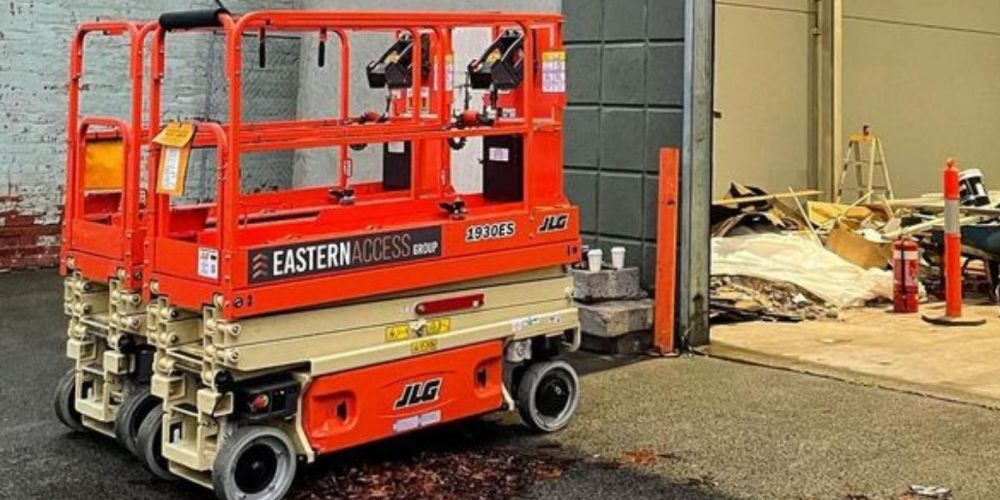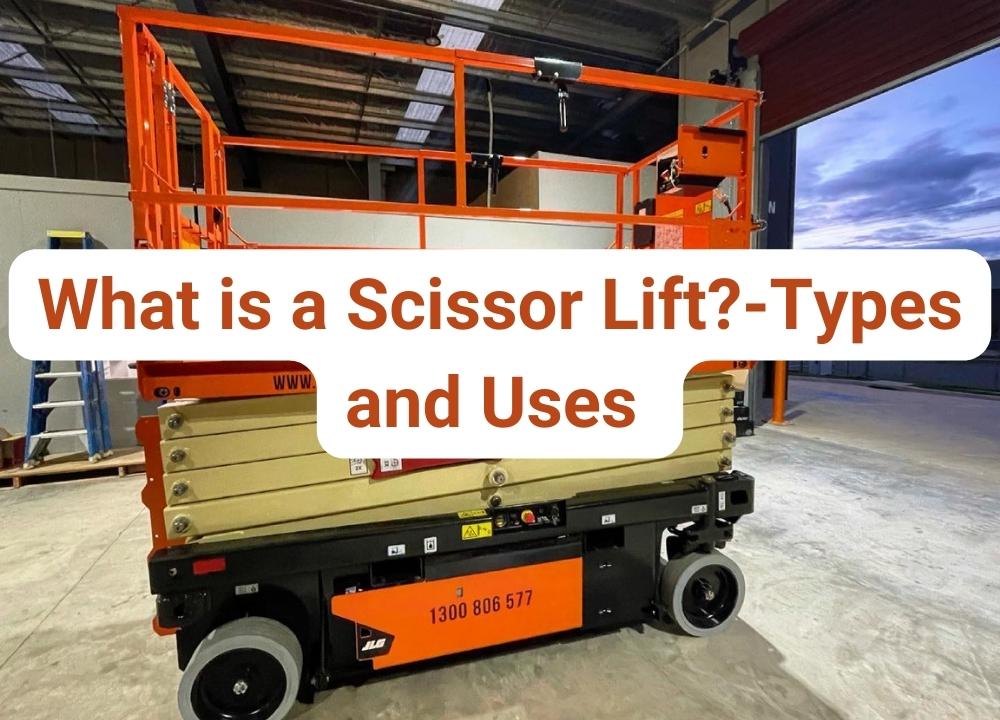What is a Scissor Lift? - Types and Uses
Scissor lifts are man lift used to elevate personnel and their instruments to work heights in construction and facility maintenance applications.
EWP scissor lifts don’t have a telescope or rotary capability, unlike a boom type. They utilized connected, folding supports in an “X” pattern, the unit’s elevating mechanism.
Scissor lifts can be self-propelled and mounted on a trailer or a vehicle. They can come with outriggers or stabilizers as an option.
Are you planning to hire and use a scissor lift? Join us as we talk about and introduce one of the most efficient and commonly used elevated work platforms for aerial works.
Table of Contents
What are Scissor Lifts?

A scissor lift enables personnel to complete precise operations at high heights, from close inspections to cable wiring, by providing a secure, solid containment and a rising platform.
A scissor lift is a particular construction lift equipped with a platform to carry people and objects to high places. There are essential distinctions between scissor lifts and boom lifts, both forms of construction lifts. For jobs where height is not an issue, a scissor lift is a more practical and cost-effective alternative since it can elevate numerous personnel simultaneously while moving up and down.
Types of Scissor Lifts
1. Hydraulic Scissor Lifts
Heavy industrial and construction equipment can be lifted inside and outside buildings using hydraulic scissor lifts. They are perfect for usage in warehouses, workshops, building sites worldwide, and infrastructure projects. They are powered by either an electric motor or compressed air.
2. Electric Scissor Lifts
Compared to their diesel-powered predecessors, electric scissor lifts are often lighter, more compact, and have smaller, narrower platforms. They are more ecologically friendly since they use electric batteries rather than a combustion engine for power. Units are frequently equipped with non-marking tires since they work indoors, preventing floor damage.
3. Diesel Scissor Lifts
Diesel scissor lifts are noisy vehicles that run on regular diesel fuel. Diesel scissor lifts are most effective in outdoor construction where there is room for ventilation, and the noise will not disturb other employees because they exhaust fumes into the environment and are noisy. Large platforms are typically included with diesel equipment, which is advantageous while working outside.
4. Rough Terrain Scissor Lift
The rough terrain scissor lift, a prevalent form of scissor lift, has amplified power for boosting productivity in difficult outdoor job areas. Typically, internal combustion engines—either diesel, petrol, or gas—power scissor lifts. Large building sites require outstanding traction and speed, which increased productivity offers.
5. Air-Powered Scissor Lifts
Because pneumatic scissor lifts are powered by air rather than electricity or hydraulics, they are exceedingly clean and require no maintenance.
They are perfect for businesses that wish to operate sustainably and have less carbon impact since they raise and lower the lift using air pressure.
Scissor Lifts Sizes
- 19-Foot Scissor Lift
- 26-Foot Scissor Lift
- 32-Foot Scissor Lift
- 40-Foot Scissor Lift
- 50-Foot Scissor Lift
What Are Scissor Lifts For?
Maintenance
A scissor lift is frequently needed for commercial and residential premises maintenance. A raised platform is typically needed for tasks like changing electrical fixtures, washing windows, and switching out signs and banners. In addition, electrical versions are appropriate for use in institutions like churches, schools, and hospitals.
Shipping and Transportation
Electrical scissor lifts are essential for moving, shipping, and storing pallets, containers, and other commodities. Scissor lifts are utilized in the transportation industries of air, land, and sea to store and retrieve items from vehicle storage surfaces and store goods on raised shelves after they reach their destination.
Access Height and Difficult-to-Reach Spots
Scissor lifts allow workers to access high places that would be otherwise unreachable with lift heights up to 16 meters.
Workers can access regions too challenging to reach to perform maintenance, repairs, or cleaning.
Construction
Electrical scissor lifts have a wide range of applications on building sites, particularly inside. These raised work platforms come in helpful for concrete pouring, overhead welding, and bricklaying. Both ordinary construction work and rehabilitation contracts employ electrical scissor lifts.
Putting up Signages
There are a lot of signs around us that change regularly, from little businesses to property managers with several sites. If you buy or rent a scissor lift, you can avoid some of the worries and issues of making such modifications. Workshops for mechanics, utilities for storage facilities, and parking lot upkeep are a few industries that frequently modify their signs.
Tips When Using Scissor Lifts
As with any aerial lift, scissor lifts need to be oriented to and trained before being used. Operators will need to be aware of the exact relationship between the lift’s maximum height and other things, such as the outside power lines and the ceiling of a building. Anyone operating the scissor lift must know its controls, typical operations, and emergency procedures.
Here are the common problems we sometimes personally encounter while using scissor lifts:
- You cannot undo the lifting process.
- Either the lifting platform is either flimsy or too hefty to raise
- The lifting platform automatically descends.
- When the down valve malfunctions, the lifting platform does not descend.
- The descending valve is jammed or broken, making it impossible to close.
Ways To Be Safe When Working With Scissor Lifts
- Always know where and how to use the lift’s emergency stop and lowering mechanism.
- Avoid using the scissor lift by yourself.
- Use safety harnesses and other PPE at all times.
- When working on a higher platform, keep all tools locked away.
- Before operating a scissor lift, thoroughly inspect the task location, considering the ground under the base and the height at which the operator will work. Search for branches, exposed or dangling cables, rafters, etc.
- Never use a scissor lift unless you have received the appropriate training.
- Only try to move an extended scissor lift or the lift while someone else is on it.
Frequently Asked Questions
Scissor lifts are incredibly secure and safe. However, if not utilized appropriately, any piece of equipment might become harmful. Always adhere to the maximum weight recommendations and manufacturer’s directions to keep scissor lifts safe. Only use a scissor lift if you have been appropriately trained. Avoid using one of the task locations is unsafe.
The scissor lifts grow increasingly unstable when a platform is elevated higher. This makes the scissor lifts’ inherent wobble worse. The chance that a man lift may go over increases as weight is added to the platform.
On uneven or sloping ground, scissor lifts can use the outdoors. A rough terrain scissor lift was explicitly created to function on unlevel or rugged terrain, making it possible to raise personnel and materials securely in a way that a ladder simply cannot.
A scissor lift will only track the time it spends moving, so if you are hanging drywall or performing electrical work, those hours are not being tracked. Therefore, we estimate that a scissor lift can operate for 500 to 1,000 hours.
Conclusion
A mechanical device known as a scissor lift uses electric power as a source of propulsion to lift or unload objects. It is mainly used in high-altitude homework-related industries, fields, and professions such as business, the chemical industry, local government, electric power, and transportation. Consider the wide varieties, uses, and advantages while choosing the best scissor lift.
And to make things easier for you, choose the right EWP to hire companies that offer the best and most reliable equipment and customer service to make your task run as smooth as possible.

